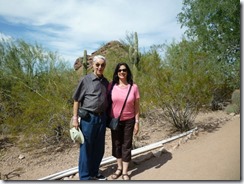Setting is an integral part of any writer’s story arsenal, and sometimes you have to go to a place in person to learn more about it. Arizona was as foreign a setting to me as stepping foot on another planet. Expanses of red dirt dotted with scrub brush and cacti plus mountains stretching into the distance boggled my imagination. What were those wondrous plants called? The saguaro cactus made its remarkable presence known immediately, its tall stalks reaching toward the sky.
But what were those beautiful green-barked trees or that intriguing purplish cacti? And why did my cousin warn me away from those lovely flowering cactus plants?
A trip to the Desert Botanical Gardens proved illuminating. Taking notes and photos as we roamed, I learned more than the names of the flora decorating the desert landscape. I learned not to rely on a mountain as a landmark. Oh, the entrance is opposite that mountain there? Well, guess what? There was more than one peak! My cousin and I got lost trying to find the exit. Yep, this intrepid author, armed with notebook and camera, couldn’t even find her way out of the park. Thirsty and tired, we finally met up with my husband in the gift shop and immediately headed to the café for cold drinks.
How might this relate to my story? My heroine, Marla, could easily get lost on a path like this same as me. Only in her case, a killer might be on her tail.
The park lists four deserts in North America: the Mojave, the Great Basin, the Chihuahuan, and the Sonoran which is where we are located. Here are some of the plants we identified.
The dangerous plant that looks seductively appealing is the Cholla bush. Its sharp needles can blow off in a breeze and pierce your skin. Steer clear in a wind.
I liked the purplish prickly pear cactus with its elephant ears, as they’re called. Being a Floridian, to me they looked like Mickey Mouse ears.
My favorite trees are the green-barked Palo Verde and the shady Mesquite. No doubt Marla will stand in its shade at some time during my story, or she might trip over a creeping devil that hugs the ground like a snake. At least I’ll know what to call some of these plants now, and if I don’t have it in my notes, I can look it up in Cactus of Arizona Field Guide or the pamphlet on Arizona Trees & Wildflowers that I bought. Truly I was surprised by the abundance of greenery. The scenic beauty can grow on you.
So where are we going next on our virtual tour? To the Grand Hotel in Jerome, an old mining town. We stayed overnight at the haunted hotel and took a ghost hunting tour.




















































